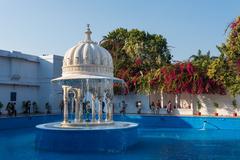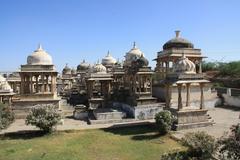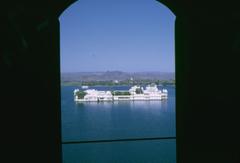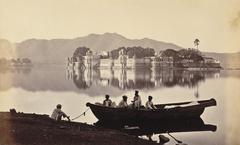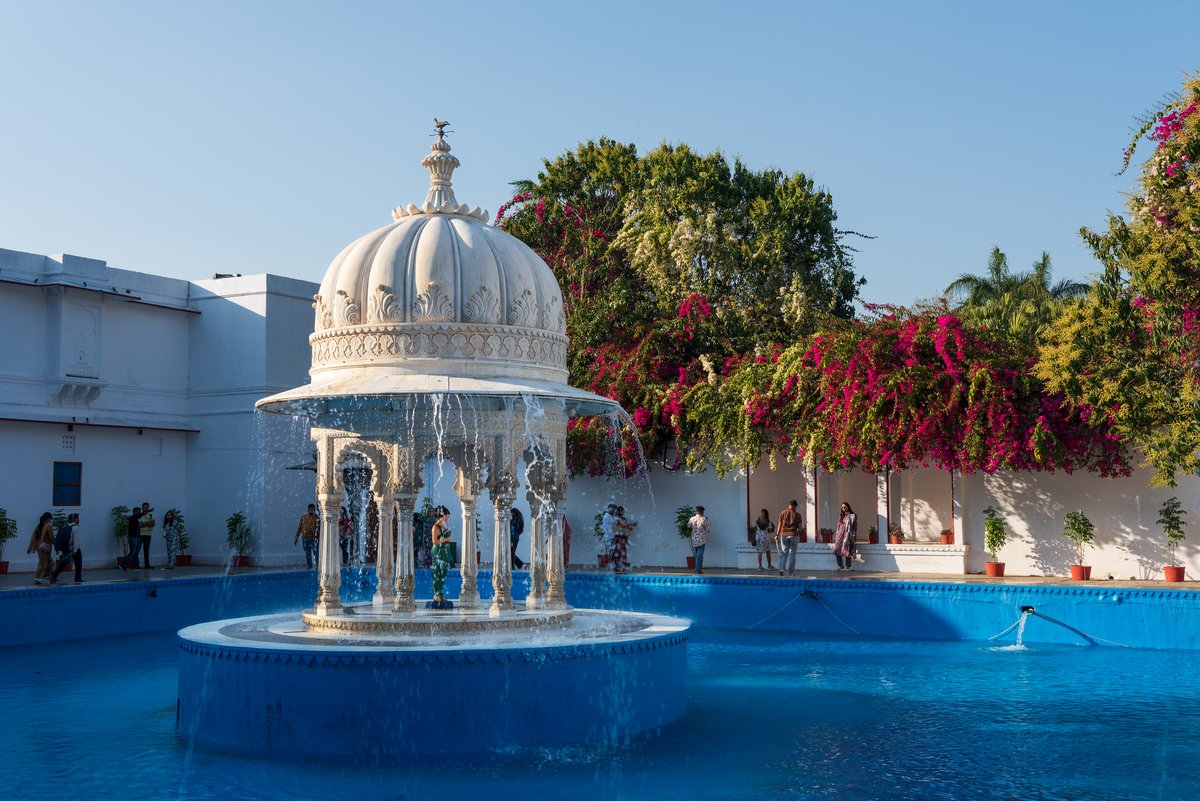
Saheliyon-Ki-Bari: Visiting Hours, Tickets, and Historical Significance
Date: 17/07/2024
Introduction
Saheliyon-Ki-Bari, also known as the ‘Courtyard of the Maidens,’ is a verdant oasis located in the heart of Udaipur, Rajasthan. This historical garden, renowned for its intricate marble carvings, playful fountains, and lush greenery, was commissioned by Maharana Sangram Singh II in the early 18th century (source). Unlike the grandiose palaces and forts that dominate Udaipur’s skyline, Saheliyon-Ki-Bari offers a serene and intimate glimpse into the lives of the royal women who once frequented its pathways. The garden was designed as a tranquil retreat for the queen and her entourage of 48 maids, providing them with a space to relax and socialize away from the palace’s formal constraints. Today, it stands as a testament to the artistic and cultural sensibilities of a bygone era, attracting visitors from around the world who seek to experience its timeless beauty and historical significance. This comprehensive guide will delve into the garden’s rich history, architectural marvels, and practical visitor information, ensuring you have all the insights needed for a memorable visit.
Table of Contents
- Introduction
- History and Significance
- The Vision of a King - Maharana Sangram Singh II (1710-1734)
- A Royal Gift - A Token of Love and Camaraderie
- An Oasis of Feminine Energy - Designed by Women, for Women
- Evolution Through Time - From Pleasure Garden to Public Space
- Architectural Heritage - A Blend of Mughal and Rajput Aesthetics
- The Symbolism of Water - Fountains, Pools, and the Lotus Collection
- Visitor Information
- Travel Tips
- Conclusion
- FAQs
- Call to Action
History and Significance
The Vision of a King - Maharana Sangram Singh II (1710-1734)
The credit for conceptualizing and commissioning Saheliyon-Ki-Bari goes to Maharana Sangram Singh II, the ruler of Mewar from 1710 to 1734. Unlike the imposing forts and palaces that dominate Udaipur’s landscape, this garden was envisioned as a sanctuary of peace and tranquility.
A Royal Gift - A Token of Love and Camaraderie
Legend has it that Maharana Sangram Singh II designed Saheliyon-Ki-Bari as a special gift for his queen. The garden was intended to provide the queen and her entourage of 48 maids, who accompanied her as part of her dowry, a respite from the confines of palace life. It was a place where they could relax, socialize, and enjoy the beauty of nature.
An Oasis of Feminine Energy - Designed by Women, for Women
Adding another layer to its unique history, Saheliyon-Ki-Bari is said to have been designed by the women of the royal court. This female perspective is evident in the garden’s layout and features, which prioritize elegance, grace, and a celebration of nature’s beauty. It was a space conceived and brought to life by women, reflecting their tastes and sensibilities.
Evolution Through Time - From Pleasure Garden to Public Space
Over the centuries, Saheliyon-Ki-Bari has undergone several renovations and additions, each leaving its mark on the garden’s character. While it initially served as a private retreat for the royal women, it was later opened to the public, becoming a cherished green space for locals and tourists alike.
Architectural Heritage - A Blend of Mughal and Rajput Aesthetics
The architectural style of Saheliyon-Ki-Bari reflects a harmonious blend of Mughal and Rajput influences. The intricate marble carvings, delicate fountains, and lush greenery showcase the grandeur of Rajput architecture, while the formal layout and use of water channels hint at Mughal inspiration. This fusion of styles creates a unique visual vocabulary that is both captivating and serene.
The Symbolism of Water - Fountains, Pools, and the Lotus Collection
Water plays a central role in the design and ambiance of Saheliyon-Ki-Bari. The garden is adorned with numerous fountains, pools, and water channels, which not only enhance its aesthetic appeal but also contribute to its tranquil atmosphere. The lotus flower, a symbol of purity and enlightenment in Indian culture, features prominently in the garden’s design, further emphasizing the connection to water and its spiritual significance.
Visitor Information
Saheliyon-Ki-Bari Visiting Hours
The garden is open daily from 9:00 AM to 7:00 PM, allowing visitors ample time to explore its beauty and historic significance.
Saheliyon-Ki-Bari Tickets
The entrance fee is nominal, making it accessible for everyone. For the latest ticket prices, it is advisable to check the official website or local tourist information centers.
Special Events and Guided Tours
Saheliyon-Ki-Bari occasionally hosts cultural events and guided tours, which provide deeper insights into its history and significance. Check the official website for upcoming events and tour schedules.
Travel Tips
Best Time to Visit
- Winter (October - March): This is the peak tourist season in Udaipur. The weather is pleasantly cool and ideal for exploring outdoor attractions like Saheliyon-Ki-Bari.
- Monsoon (July - September): The gardens are at their lushest during the monsoon season, with the fountains and water channels flowing generously. The air is fresh and the atmosphere is romantic, making it a unique time to visit. However, be prepared for occasional showers.
- Summer (April - June): Udaipur experiences scorching summers. While the gardens are open, it’s best to avoid visiting during peak afternoon hours due to the intense heat.
Nearby Attractions
- Fateh Sagar Lake: Located nearby, Fateh Sagar Lake offers boating opportunities and stunning views, especially at sunset.
- City Palace: A magnificent palace complex showcasing the grandeur of Rajput architecture.
- Jag Mandir: A picturesque palace on an island in Lake Pichola, accessible by boat.
Accessibility
The garden is easily accessible by local transportation, and facilities are available for differently-abled visitors.
Photography Spots
- The lush greenery, intricate fountains, and marble carvings provide excellent photographic opportunities.
- Capture the Fountains: Experiment with different shutter speeds to capture the water in motion.
- Frame the Architecture: Use the arches and doorways to create interesting frames.
- Golden Hour Magic: The soft light during the golden hours (sunrise and sunset) can enhance the beauty of the garden.
- Details and Textures: Zoom in on the intricate details of the carvings, the textures of the marble, and the vibrant colors of the flowers.
Conclusion
Saheliyon-Ki-Bari remains a cherished landmark in Udaipur, embodying the elegance and sophistication of its royal past. Its meticulously designed gardens, adorned with marble pavilions, lotus pools, and intricate fountains, offer a peaceful retreat that continues to captivate both locals and tourists. The garden’s unique history, from its inception as a royal sanctuary to its evolution into a public space, reflects the enduring allure of nature and artistry intertwined. As you wander through its leafy pathways, you’re transported back in time, gaining a deeper appreciation for the cultural heritage and architectural brilliance of the Mewar dynasty. Whether you’re a history enthusiast, a nature lover, or simply seeking a tranquil escape, Saheliyon-Ki-Bari promises an enriching and unforgettable experience. For those planning to visit, remember to check the latest ticket prices and event schedules on the official website or local tourist information centers. To enhance your Udaipur journey, consider exploring nearby attractions such as the City Palace, Lake Pichola, and Jagdish Temple. Your visit to Saheliyon-Ki-Bari will undoubtedly be a highlight, offering a serene respite and a profound connection to the royal legacy of Rajasthan (source).
FAQs
- What are the visiting hours of Saheliyon-Ki-Bari? The garden is open daily from 9:00 AM to 7:00 PM.
- How much is the entrance fee? The entrance fee is nominal; check the official website for the latest prices.
- Are there guided tours available? Yes, guided tours are available and can be checked on the official website for schedules.
- What is the best time to visit Saheliyon-Ki-Bari? The cooler months from October to March are the best time to visit.
- Is Saheliyon-Ki-Bari accessible for differently-abled visitors? Yes, the garden has facilities to accommodate differently-abled visitors.
Call to Action
For more insights into Udaipur’s historical sites and travel tips, follow us on social media and download our mobile app Audiala. Don’t miss out on our other related posts for a comprehensive travel experience.
References
- Rajasthan Tourism, n.d., Rajasthan Tourism https://www.rajasthantourism.gov.in
- Udaipur Tourism, n.d., Udaipur Tourism https://www.udaipurtourism.com
